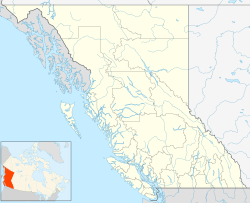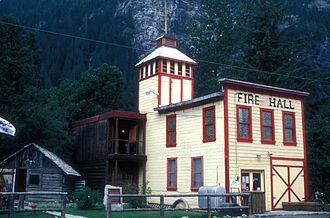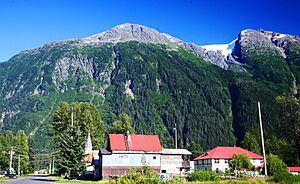Stewart, British Columbia facts for kids
Quick facts for kids
Stewart
|
|
|---|---|
|
District municipality
|
|
| District of Stewart | |
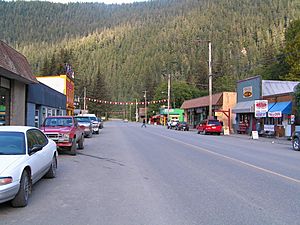 |
|
| Country | Canada |
| Province | British Columbia |
| Regional district | Kitimat–Stikine |
| Incorporated | 1930 |
| Area | |
| • Total | 552.08 km2 (213.16 sq mi) |
| Elevation | 0 m (0 ft) |
| Population
(2016)
|
|
| • Total | 401 |
| • Density | 0.7263/km2 (1.8812/sq mi) |
| Time zone | UTC−8 (PST) |
| Postal Code 0098 |
V0T 1W0
|
| Area code(s) | 250, 778, 236 |
| Highways | |
Stewart is a small town located in the northwest part of British Columbia, Canada. It's right at the end of the Portland Canal, which is a long, narrow arm of the sea, close to the border of Alaska. In 2021, about 517 people lived here. Stewart is known for its beautiful natural surroundings, including the famous Salmon Glacier.
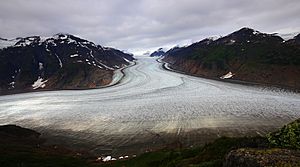
Contents
Exploring Stewart's Past: A Look at Its History
The area where Stewart is now located has a long history. The Nisga'a people, who live near the Nass River, called the head of Portland Canal Skam-A-Kounst. This name means "safe house" or "strong house." It was likely a safe place for them to go when they were bothered by the Haida and Tlingit from the coast. The Nisga'a would visit the area during certain seasons to pick berries and hunt birds.
Before the Nisga'a, the Tsetsaut people lived here. They were also known as the Skam-a-Kounst Indians. However, they faced many challenges like war and sickness. They were eventually forced out of the Stewart area around 1856–57.
First Explorers and Settlers in Stewart
The Portland Canal was first explored and named in July 1793 by Captain George Vancouver. He named it after William Cavendish-Bentinck, 3rd Duke of Portland. Captain Vancouver even met two friendly native people at the spot where Stewart is today.
Later, in 1896, Captain David du Bose Gaillard explored the area again. He was from the United States Army Corps of Engineers. Just two years after his visit, the first prospectors and settlers arrived. Among them was D. J. Raine, who has a creek and a mountain named after him.
The Stewart brothers arrived in 1902. In 1905, Robert M. Stewart, who became the first postmaster, officially named the town Stewart.
Mining History and Economic Growth
In the early days, finding gold and silver was very important for Stewart's economy. Nearby Hyder, Alaska, became a busy place when rich silver was found in the Salmon River area in 1917 and 1918. Hyder was used as a place to get supplies for the mines. Stewart served as the main port for Canadian mining. This mining was mostly focused on the town of Premier, which was about 14 kilometers (9 miles) from Hyder.
Other mines in the area included the Jumbo, BC Silver, Red Cliff, and Porter-Idaho. There were also larger mining camps south of Stewart at Anyox and Maple Bay.
Stewart in Movies
Stewart has even been a filming location for movies! Parts of Disney's Eight Below, which starred Paul Walker and Jason Biggs, were filmed here. Also, the outdoor scenes for John Carpenter's science fiction movie The Thing were filmed near the Salmon Glacier.
Stewart's Population: How Many People Live Here?
In the 2021 Canadian census, Statistics Canada reported that Stewart had a population of 517 people. These people lived in 256 of the town's 337 homes. This was an increase from its 2016 population of 401 people. Stewart covers a land area of about 551.57 square kilometers (212.96 square miles).
Getting to Stewart: Transportation Options
You can reach Stewart in a few ways:
- By Road: You can drive there using British Columbia Highway 37A, which is part of British Columbia's highway system.
- By Boat: Boats can travel to Stewart through the Portland Canal.
- By Air: You can also fly into Stewart Airport.
Where is Stewart Located?
Stewart is in a unique spot.
- To the west of Stewart is Hyder, Alaska. This town is only about 3 kilometers (1.9 miles) away.
- Northwest of Stewart is Premier, British Columbia. What's interesting about Premier is that it's in Canada, but you can only get to it by going through a part of the United States that is only accessible from Canada!
To the east of Stewart, you'll find Meziadin Junction, which is about 61 kilometers (38 miles) away. Further east is Kitwanga, British Columbia, located about 218 kilometers (135 miles) from Stewart. Even farther north is Dease Lake, British Columbia, which is about 392 kilometers (244 miles) north of Stewart. Stewart is the most northern point on Canada's Pacific coast that doesn't freeze.
Stewart's Weather: A Look at the Climate
Stewart has a type of weather called a humid continental climate. This means it gets a lot of rain and snow. On average, it receives about 1866.8 millimeters (73.5 inches) of precipitation each year. A lot of this comes down as snow.
The average yearly temperature in Stewart is about 6.1 degrees Celsius (43 degrees Fahrenheit). Because it's so close to the ocean, the weather is milder in winter compared to places further inland. Stewart is known as Canada's most northern port that stays free of ice all year. However, it's also one of the cloudiest places in the world, with only about 985 hours of sunshine each year.
| Climate data for Stewart Airport Climate ID: 1067742; coordinates 55°56′10″N 129°59′06″W / 55.93611°N 129.98500°W; elevation: 7.3 m (24 ft); 1981–2010 normals, extremes 1910–present |
|||||||||||||
|---|---|---|---|---|---|---|---|---|---|---|---|---|---|
| Month | Jan | Feb | Mar | Apr | May | Jun | Jul | Aug | Sep | Oct | Nov | Dec | Year |
| Record high humidex | 9.4 | 10.4 | 15.2 | 25.3 | 30.1 | 38.9 | 39.0 | 37.5 | 28.3 | 21.2 | 10.5 | 9.9 | 39.0 |
| Record high °C (°F) | 13.3 (55.9) |
11.7 (53.1) |
17.1 (62.8) |
25.5 (77.9) |
31.7 (89.1) |
35.0 (95.0) |
33.4 (92.1) |
32.7 (90.9) |
30.6 (87.1) |
20.6 (69.1) |
14.4 (57.9) |
11.2 (52.2) |
35.0 (95.0) |
| Mean daily maximum °C (°F) | −0.5 (31.1) |
2.3 (36.1) |
5.8 (42.4) |
11.0 (51.8) |
15.8 (60.4) |
18.9 (66.0) |
19.8 (67.6) |
18.8 (65.8) |
14.7 (58.5) |
8.9 (48.0) |
2.7 (36.9) |
0.1 (32.2) |
9.9 (49.8) |
| Daily mean °C (°F) | −3.0 (26.6) |
−1.1 (30.0) |
1.9 (35.4) |
6.1 (43.0) |
10.7 (51.3) |
13.9 (57.0) |
15.1 (59.2) |
14.3 (57.7) |
11.1 (52.0) |
6.3 (43.3) |
0.6 (33.1) |
−2.1 (28.2) |
6.1 (43.0) |
| Mean daily minimum °C (°F) | −5.5 (22.1) |
−4.5 (23.9) |
−2.0 (28.4) |
1.1 (34.0) |
5.5 (41.9) |
8.9 (48.0) |
10.4 (50.7) |
9.8 (49.6) |
7.4 (45.3) |
3.6 (38.5) |
−1.7 (28.9) |
−4.3 (24.3) |
2.4 (36.3) |
| Record low °C (°F) | −30.0 (−22.0) |
−28.3 (−18.9) |
−23.3 (−9.9) |
−13.9 (7.0) |
−4.4 (24.1) |
−2.8 (27.0) |
0.0 (32.0) |
−5.0 (23.0) |
−3.9 (25.0) |
−12.8 (9.0) |
−24.8 (−12.6) |
−26.1 (−15.0) |
−30.0 (−22.0) |
| Record low wind chill | −30.1 | −29.2 | −25.7 | −12.2 | −1.3 | 0.0 | 0.0 | 0.0 | −2.7 | −13.0 | −36.7 | −32.5 | −36.7 |
| Average precipitation mm (inches) | 238.0 (9.37) |
137.0 (5.39) |
121.8 (4.80) |
89.1 (3.51) |
72.3 (2.85) |
65.6 (2.58) |
73.0 (2.87) |
122.4 (4.82) |
217.3 (8.56) |
278.0 (10.94) |
230.1 (9.06) |
222.2 (8.75) |
1,866.8 (73.50) |
| Average rainfall mm (inches) | 88.1 (3.47) |
57.6 (2.27) |
85.6 (3.37) |
73.4 (2.89) |
71.8 (2.83) |
65.6 (2.58) |
73.0 (2.87) |
122.4 (4.82) |
217.3 (8.56) |
268.3 (10.56) |
123.9 (4.88) |
91.9 (3.62) |
1,338.9 (52.71) |
| Average snowfall cm (inches) | 162.8 (64.1) |
85.6 (33.7) |
38.8 (15.3) |
15.8 (6.2) |
0.5 (0.2) |
0.0 (0.0) |
0.0 (0.0) |
0.1 (0.0) |
0.0 (0.0) |
9.7 (3.8) |
112.7 (44.4) |
144.3 (56.8) |
570.2 (224.5) |
| Average precipitation days (≥ 0.2 mm) | 20.0 | 15.1 | 18.2 | 16.6 | 16.1 | 15.4 | 16.4 | 17.4 | 20.2 | 23.3 | 21.4 | 20.5 | 220.5 |
| Average rainy days (≥ 0.2 mm) | 11.4 | 10.3 | 15.8 | 16.4 | 16.1 | 15.4 | 16.4 | 17.4 | 20.2 | 23.2 | 16.1 | 12.0 | 190.6 |
| Average snowy days (≥ 0.2 cm) | 14.3 | 9.2 | 7.2 | 2.5 | 0.08 | 0.0 | 0.0 | 0.04 | 0.0 | 1.7 | 10.8 | 14.7 | 60.6 |
| Average relative humidity (%) | 86.0 | 79.6 | 70.1 | 57.4 | 52.8 | 58.3 | 65.3 | 70.4 | 77.3 | 80.8 | 87.7 | 89.5 | 72.9 |
| Mean monthly sunshine hours | 25.7 | 40.0 | 73.5 | 119.8 | 157.7 | 145.0 | 138.1 | 126.5 | 85.2 | 39.9 | 19.7 | 14.4 | 985.4 |
| Percent possible sunshine | 10.8 | 14.9 | 20.1 | 28.2 | 31.2 | 27.7 | 26.3 | 27.1 | 22.2 | 12.3 | 7.9 | 6.5 | 19.6 |
| Source: Environment Canada wind chill | |||||||||||||


